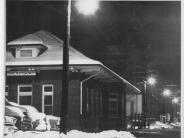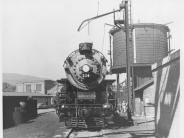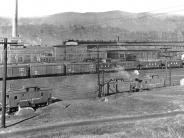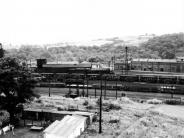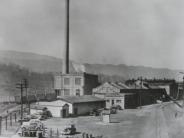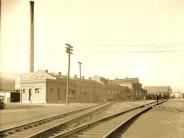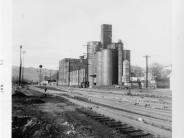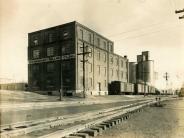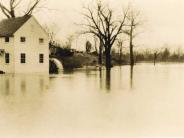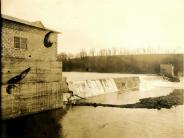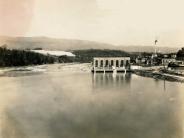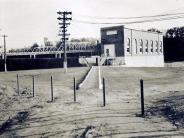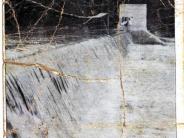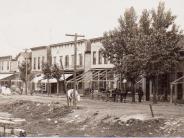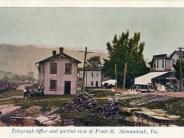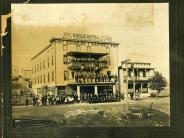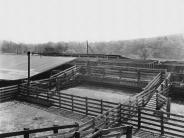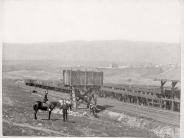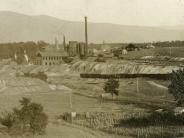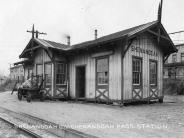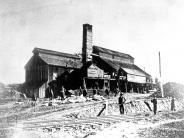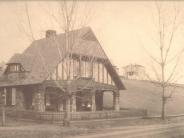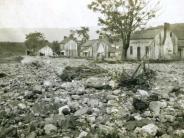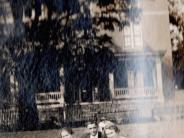History
In 1837, two brothers, Daniel and Henry Forrer, purchased approximately 1,100 acres of land, which included the land in the current Town limits. Shortly after making this land acquisition, the Forrers built the Shenandoah Iron Works for the purpose of producing and forging pig iron. The Forrer brothers became the original founders of the Town of Shenandoah. The first post office was established in February of 1838 under the name of Shenandoah Iron Works.
In 1855 the Forrer House was constructed. The Forrer House is a 4-story mansion with 22 rooms constructed of handmade bricks shipped from England. The home was located on Long Avenue but has since been demolished.
The Shenandoah community continued to develop following the establishment of a post office. A Mr. Pee Dee built ten houses in a row in Furnace Hollow and four double houses facing the river, south of the present Methodist Cemetery. This section of Shenandoah became known as Pee Dee. In 1867, Captain Cooke built a home on the River Road for his son-in-law, Peter Jefferson Propes. Floodwaters reached ten feet deep at this house in 1870. Another early part of Shenandoah is known as Miller’s Addition.
The Town of Shenandoah is listed on the National and State Registers of Historic Places. This Historic District includes 451 buildings, 3 sites and 4 structures and encompasses portions of First, Second, Third, Fourth, Fifth, Sixth, Seventh, Eighth, and H Streets, Central, Denver, Long, Maryland, Pennsylvania, and Virginia Avenues, and Coverstone Lane. Other structures in and around the Town listed by the Virginia Historic Landmark Commission include the Stevens Cottage on the corner of Maryland Avenue and Second Street, the South Fork House off of Route 340 north of Town, the Mt. Lebanon United Church at Comertown and the Old Verbena Mill at Verbena south of Town off of Route 340.
The historic pattern of development in Shenandoah has always fronted the Shenandoah River. A wagon road along the riverbank in Shenandoah served as the original thoroughfare. This road extended the length of the Page Valley. The Shenandoah Iron Works constructed buildings next to this road, and residential areas spread out to the north and west.
During this period, the Shenandoah River could be crossed either by fording or ferrying. The ferry served the people of Shenandoah and crossed 100 yards south of the present bridge, which is now part of Route 602.
From 1861 to 1865, the Confederate Government built and operated a gunpowder plant near town on the west side of the Shenandoah River, one mile north of the river bridge. Shenandoah industries forged iron into solid bars and shipped them to the cannon factory in Richmond, Virginia. The powder plant also produced and shipped cast cannon balls and gunpowder.
The arrival of William Milnes, Jr., and Thomas Johns in 1866 heralded an era of prosperity and growth for Shenandoah. In 1867, these men purchased thirty-two thousand acres, including the Shenandoah Iron Works. They continued the Forrers’ Iron Works but introduced patented tools and machinery to improve production.
The pattern of development along the east bank of the Shenandoah River, including the forge, furnace, and the major road, caused the Town to be built in the flood plain. On September 28-29, 1870, the floodwaters washed away most of the Town. The loss included thirty to sixty structures, including manufacturing buildings, machinery, offices, stables, a large store, warehouses, a river bridge, flourmill and some of the best residences. The flood washed out and destroyed the land beyond recognition.
During this time, the nation experienced an era of prosperity, which enabled Shenandoah to recover rapidly from the flood’s destruction. In 1870, a public school was constructed, and many new businesses opened.
Despite the flood, industrial activities continued. Between 1870 and 1880 William Milnes worked with leaders between Hagerstown, Maryland, and Roanoke, Virginia, to try and get a railroad built through Page County. Milnes saw his dreams come true in 1881, when the railroad from the north reached the Shenandoah Iron Works. A connection to Roanoke followed in 1882, and this became known as the Shenandoah Valley Railroad. A telegraph line was built along with the railroad.
As soon as the railroad was assured, Milnes erected the Big Gem Cast Iron Furnace under the name of the Shenandoah Iron, Lumber, Mining and Manufacturing Company. Big Gem, with its great boilers, large casting room, and high smokestacks was completed in 1882. The name of the company was later changed to Shenandoah Furnace Company, and later still to Empire Steel and Iron Company, and finally to the Allegheny Ore and Iron Company.
On June 27, 1882, the name of the post office was changed from Shenandoah Iron Works to Milnes. An Act of the General Assembly of the State of Virginia was passed on February 12, 1884 to incorporate the Town. It bore the name Milnes in honor of William Milnes, Jr., President of the Shenandoah Valley Railroad.
The original corporate limits of the Town never changed until the friendly boundary line adjustment between the Town and Page County became effective, January 1, 2007.
The Railroad built tracks above the river flood plain parallel with First Street, which became the main street of commercial activity in Shenandoah. Businesses established themselves in buildings constructed on only one side of First Street so that they could face the railroad yards and the Shenandoah River. First Street continued from Maryland Avenue to Junior Avenue on the east side of the railroad. There was a bridge on Main Street across Virginia Avenue and another at the old Y.M.C.A. building. Both were high enough to drive a wagon underneath. Poles were laid along the streets of the town for curbing and were filled in with engine cinder for sidewalks.
Mr. Milnes gave a building lot to each church denomination to be used for a church building. He also gave sixty acres of land to the railroad company to be used for the terminal shops, as well as lots on Third Street for public schools.
The output of cast iron at Big Gem reached one hundred and ten (110) tons daily. The furnace became a well-known tourist attraction due to the spectacular shower of sparks that could be seen each night when a kettle of red-hot cinder was poured down the cinder bank. Oftentimes, the streets were made more serviceable by spreading a layer of Big Gem cinder over them.
On March 8, 1890, the name of the post office was changed from Milnes to Shenandoah. Thereafter, the name of the town was changed, by an Act of the General Assembly, from Milnes to Shenandoah City. During the following years, the word “city” was informally dropped from the Town’s name.
In 1890, Shenandoah experienced a sudden and rapid growth known as the “boom”. This was brought about by a national era of growth and the advertising efforts of the Shenandoah Land and Improvement Company.
The Shenandoah Land Improvement Company bought land around the Town and surveyed the entire corporate limits as well as their own land. The streets were staked, a map made, and a land sale conducted. There were great increases in land prices and one lot on Tenth Street sold for as much as $2,000.
The Shenandoah Land Improvement Company also erected many buildings. Most of these buildings have been demolished or destroyed by fire.
In 1890, the first river bridge was built across the Shenandoah River. For many years after, a toll was charged to cross the bridge.
A very large and luxurious frame hotel, known as “The Shenandoah,” was built on the crest of the hill on First Street, south of Maryland Avenue. The hotel burned in 1891 and was rebuilt the following year. It never operated as a hotel again, but served as an apartment house for ten years before finally being torn down. Broad Hall, on Maryland Avenue at Seventh Street, was built for Mr. Flickwir who was active in the Shenandoah Land Improvement Company, Furnace Company, and the Railroad Company.
The Furnace Company built a huge rolling mill along the river and the railroad. Machinery was installed, but it was never operated.
In 1891, the “boom” collapsed and a general depression settled over the entire country. Banks closed their doors and many businesses went bankrupt. A degree of prosperity was maintained in Shenandoah due to the continued operation of the Furnace Company and the Railroad. Shenandoah’s growth continued unchecked, and the population increased from 751 in the 1890 census to 1,878 by the 2000 census.
The Norfolk and Western Railroad (N&W) took over the Shenandoah Valley Railroad in 1891. Large railroad repair and maintenance facilities were built in Shenandoah over the years. The old train station, which was built around 1900, is located on the south side of First Street.
In 1896, a flood washed away the eastern portion of the river bridge. During that same year, a fire destroyed the business section from the modern day post office on Virginia Avenue to the Shenandoah Municipal Building on First Street. In 1904, another fire destroyed a large part of the remaining business section, including three hotels, two storerooms and almost all of the existing buildings.
The Town installed a steam electric power plant and water system in 1906. The Big Gem Furnace discontinued operation in 1907. Parts of it were sold, and finally in 1917, it was completely dismantled. Between 1890 and 1900, the Town experienced high population growth (62.5 %), but this slowed considerably between 1900 and 1910 (17.3%).
In November 1916, a fired destroyed the N&W round house and machine shop. Following the fire, a broad program of reconstruction with modern facilities and equipment began. Norfolk and Western completed construction on a new 21 stall round house in the spring of 1918, and a large powerhouse and a modern shop in 1925.
N&W operated its main overhaul and repair facilities in Shenandoah and at times employed over 400 men. The railroad’s prosperity is reflected by the population increase that took place between 1910 and 1920 to 1,895 persons.
In 1918, Shenandoah installed a filter plant for the water system and also constructed a dam in the river to furnish hydroelectric power. The Town erected a powerhouse on the center of the dam. In 1924, a flood caused severe damage to the dam and powerhouse. Three years later, Shenandoah sold its light and water system to the Massanutten Power Corporation, which later became Potomac Edison Power Company, and then Allegheny Power. The Town is currently served electric power by Shenandoah Valley Electric Co-op.
The Virginia Department of Highways built Route 340 along Fourth Street in 1924.
Between 1930-1939 Shenandoah laid concrete sidewalks and surfaced its streets.
A knitting mill was built in 1938 at the end of Williams Avenue on the northeast side of the Town. Following the knitting mill industry, this structure was first inhabited by North American Phillips, where the employees manufactured small motors. Finally, it was purchased by Overhead Door Company, and was known as the Genie Company, where employees manufactured garage door openers. The Genie Plant announced plans to completely close the facility in May of 2012. Tactical Walls now owns the building.
The N & W Railroad decommissioned steam-locomotives and replaced them with diesel engines in the 1950s. By 1958, the railroad shut down all but its minimum repair facilities in Shenandoah. This contributed to the decreasing town population.
In 1966, Shenandoah installed a new sewage system to serve the central portion of the Town from First Street to Ninth Street and Williams Avenue to Shenandoah Avenue. This system included a primary level wastewater treatment plant located close to the river at the end of Long Avenue.
Shenandoah Industrial Park consisting of 18 acres was purchased in 1978 and developed in 1981. The Town currently provides water and sewer service to the entire Industrial Park located on Quincy Avenue. This industrial park contains four (4) buildings. Town of Shenandoah provides police protection and surveillance in this industrial park and responds to any emergencies. Shenandoah Fire Company and Rescue Squad respond to any emergencies as well.
The Town of Shenandoah acquired the Big Gem property (68.6 acres) from Lukens Steel on September 27, 1995. This property is being developed into a recreational area to serve citizens and visitors as well. The Town has received numerous grants and donations to assist with the development of this park. Previous development of this park has included installation of a large gazebo and numerous picnic tables; large scale landscaping and walking trail development, including but not limited to split rail fencing, retaining walls, and clearing of trails; installation of a fountain in the pond; implementation of a fishing program for the pond; stairways to allow easy access to the upper portions of the park; bridges to allow access to the rear sections of the park; rain gardens to assist with environmental protection; etc. Master plans have been developed and will include additional walking trails; picnic areas; ball fields; and an amphitheater. The master plan for this park is on file at the Shenandoah Town Hall.
The Town experienced two (2) devastating fires in the First Street Historic Commercial District following the renovations. The first fire, on May 23, 2006, destroyed the apartment buildings at 102 Virginia Avenue, the Letter Perfect building at 402 First Street and Comer’s Hardware Store at 406 First Street. The second fire, on March 27, 2007, destroyed buildings at 504 and 506 First Street and the historic Eagle Hotel buildings, which stood at 512 First Street since 1907 and was undergoing renovation to convert it to mixed use, including apartments, commercial office space, and retail space.
October 2021, the Town purchased the former mill building located at 507 First Street using ARPA funds. The Town opened the Town of Shenandoah Museum and Welcome Center on June 21, 2022 at 507 First Street.


